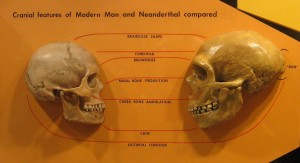Neanderthals, or hominids, were very different from modern Homo sapiens– in some ways. For example, they were generally shorter and stockier. However, some recent studies may reveal a striking similarity between Neanderthals and today’s people: speech.
In 1989, a 60,000 year old hyoid bone was found in Israel. The hyoid bone is a structure in the neck that supports the root of the tongue, making it crucial for speech. This particular hyoid bone appeared very different than that of a chimp or bonobo, which are the closest relatives to humans. Instead, it looked quite similar to the hyoid bone of a modern human. The technology of the time prevented scientists from learning much more about the structure of the hyoid and the way it may have been used. Today, technology is much more advanced.
An international team of scientists, including Associate Professor Stephen Wroe, a zoologist and paleontologist at the University of New England, have taken a closer look at the hyoid bone from Israel using 3D-imaging. Their tests allowed them to build models of the internal structures of the bone. When compared with models of modern humans, it showed that “in terms of mechanical behavior, the Neanderthal hyoid was basically indistinguishable from our own, strongly suggesting that this key part of the vocal tract was used in the same way,” A/Professor Wroe. Wroe says their research shows that the origins of language and speech may be much earlier than previously thought.
Until recently, it was believed that forms of modern language originated around 50,000 years ago. This new research however, may set it back to over 10 times that amount. It’s even possible that today’s languages share some elements of Neanderthal language. Linguists say language is gradually developed through cultural and biological evolution, not just random genetic mutations.
Through further study of this hyoid bone, and others found recently, scientists can get a better understanding of the language spoken by our ancestors. It may also show us more about the evolution of our species and what factors made us who we are today.
- What more information could be gathered from these hyoid bone studies?
- What other discoveries might be made about Neanderthals in the future?
- Could this new information mean we share other similarities with the Neanderthals?
